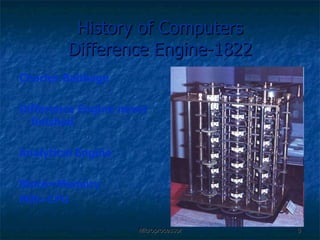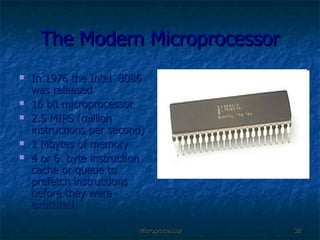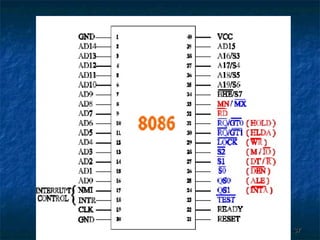Microprocessor laboratory
- 1. Microprocessor Laboratory (8086) Department of Electronics and Communications Subject code:
- 2. History of Computers The first computers were people! Picture shows what is known as “Counting Tables”
- 3. History of Computers (300 B. C, Babylonia) A very old Abacus A Modern Abacus
- 4. History of Computers Napier’s Bones-1617 The original Napier's bones Modern set of Napier’s Bones John Napier invented logarithm Successive addition=multiplication.
- 5. History of Computers Slide Rule -1632 It was still in use in the 1960’s by the NASA engineers and by the men who landed on the moon.
- 6. History of Computers Pascaline -1642 Blaise Pascal Gear driven calculator
- 7. History of Computers Punched Cards-1801 Joseph Marie Jacquard Frenchman Design of fabric was read from punched cards
- 8. History of Computers Difference Engine-1822 Charles Babbage Difference Engine never finished Analytical Engine Store=Memory Mill=CPU
- 9. History of Computers Analytical Engine Ada Byron, Countess Lady Lovelace by marriage, prepared a detailed sequence of instructions for the Analytic Engine. She earned her spot in history as the first computer programmer
- 10. History of Computers Hollerith desk-1890 In 1890 the prize was won by Herman Hollerith who helped with his invention by saving the government 5 million dollars. Punch (write) new cards based upon an analysis (reading) of some other set of cards. today called a read/write technology. Hollerith built a company, the Tabulating Machine Company which, after a few buyouts, eventually became International Business Machines, known today as IBM .
- 11. History of Computers Two types of punched cards
- 12. History of Computers 1944 World War II 25 miles target. Solving equations was laborious Harvard and IBM Mark I computer. Switches, relays, rotating shafts, and clutches. Ran non-stop for 15 years
- 13. History of Computers ”Bug” First computer "bug": a dead moth that had gotten into the Mark I and whose wings were blocking the reading of the holes in the paper tape. The word "bug" had been used to describe a defect since at least 1889 but Hopper is credited with coining the word "debugging" to describe the work to eliminate program faults.
- 14. History of Computers 1953 Grace Hopper invented the first high-level language, "Flow-matic". This language eventually became COBOL A high-level language is worthless without a program -- known as a compiler -- to translate it into the binary language of the computer
- 15. History of Computers- 1959 IBM Stretch Computer of 1959
- 16. History of Computers Apple Computer of 1976 Apple was sold as a do-it-yourself kit for $600
- 17. History of Computers Mainframe CDC 7600 Computers were expensive because of their extensive wiring
- 18. History of Computers Between Mainframe and Desk Top Minicomputers. DEC PDP-12 1969
- 19. History of Computers Between 1943 and 1945 by two professors, John Mauchly and the 24 year old J. Presper Eckert built the ENIAC
- 20. History of Computers Cables were “tested” by rats!!!!! ENIAC did humanity no favor when it declared the hydrogen bomb feasible. This first ENIAC program remains classified even today.
- 21. History of Computers Eckert and Mauchly's next teamed up with the mathematician John von Neumann to design EDVAC, which pioneered the stored program .
- 22. History of Computers After ENIAC and EDVAC came other computers with humorous names such as ILLIAC, JOHNNIAC, and, of course, MANIAC.
- 23. History of Computers Arthur C. Clarke chose to have the HAL computer of his famous book "2001: A Space Odyssey" born at Champaign-Urbana. Have you ever noticed that you can shift each of the letters of IBM backward by one alphabet position and get HAL?
- 24. History of Computers The original IBM Personal Computer (PC)
- 25. The Microprocessor Age 1971 World’s first microprocessor is Intel 4004 . 4096 4-bit wide memory locations. 45 instructions. p-channel MOSFET technology, 50 KIPS( kilo instructions per second)
- 26. Intel 4004
- 27. Technical details of the Intel 4004 Maximum clock speed was 740 kHz Instruction cycle time: 10.8 µs [12] (8 clock cycles / instruction cycle) Instruction execution time 1 or 2 instruction cycles (10.8 or 21.6 µs), 46300 to 92600 instructions per second Separate program and data storage. Contrary to Harvard architecture designs, however, which use separate buses , the 4004, with its need to keep pin count down, used a single multiplexed 4-bit bus for transferring: 12-bit addresses 8-bit instructions 4-bit data words Instruction set contained 46 instructions (of which 41 were 8 bits wide and 5 were 16 bits wide) Register set contained 16 registers of 4 bits each Internal subroutine stack 3 levels deep.
- 28. Intel 8008 3500 transistors .5 MHz 48 instructions 16 Kbytes memory The 8008 was the CPU for the very first commercial personal computers.
- 29. Bit-Byte-Nibble Bit= 0 or 1 Eight bits = byte (Bite) Four bits = Nibble (Small bite)
- 30. Intel 8080 1974 8 bit microprocessor Motorola released MC6800 8080 was TTL compatible Interfacing was much easier and less expensive. 64 Kbyte memory. First PC Altair 8800 released. BASIC language interpreter developed by Bill Gates.
- 31. Intel 8085 1977 769,230 instructions per second Internal clock generator, internal system controller and higher clock frequency About 200 million in existance.
- 32. The Modern Microprocessor In 1976 the Intel 8086 was released 16 bit microprocessor 2.5 MIPS (million instructions per second) 1 Mbytes of memory 4 or 6 byte instruction cache or queue to prefetch instructions before they were executed.
- 33. The 80286 Microprocessor 16 bit architecture microprocessor 16 Mbyte memory 4 MIPS
- 34. Intel 80386 1986 32 bit microprocessor, (32 bit data bus, 32 bit memory address) 4 G bytes of memory 275,000 transistors
- 36. Pentium pro 21 million transistors 3 integer units and a floating point unit Clock frequency 166 MHz 16 K level 1 cache, 256 K level 2 cache. 3 execution engines, 3 instructions at a time.
Editor's Notes
- #8: Technology increased jobs


























![Technical details of the Intel 4004 Maximum clock speed was 740 kHz Instruction cycle time: 10.8 µs [12] (8 clock cycles / instruction cycle) Instruction execution time 1 or 2 instruction cycles (10.8 or 21.6 µs), 46300 to 92600 instructions per second Separate program and data storage. Contrary to Harvard architecture designs, however, which use separate buses , the 4004, with its need to keep pin count down, used a single multiplexed 4-bit bus for transferring: 12-bit addresses 8-bit instructions 4-bit data words Instruction set contained 46 instructions (of which 41 were 8 bits wide and 5 were 16 bits wide) Register set contained 16 registers of 4 bits each Internal subroutine stack 3 levels deep.](https://image.slidesharecdn.com/microprocessorlaboratory-110223163853-phpapp01/85/Microprocessor-laboratory-27-320.jpg)









